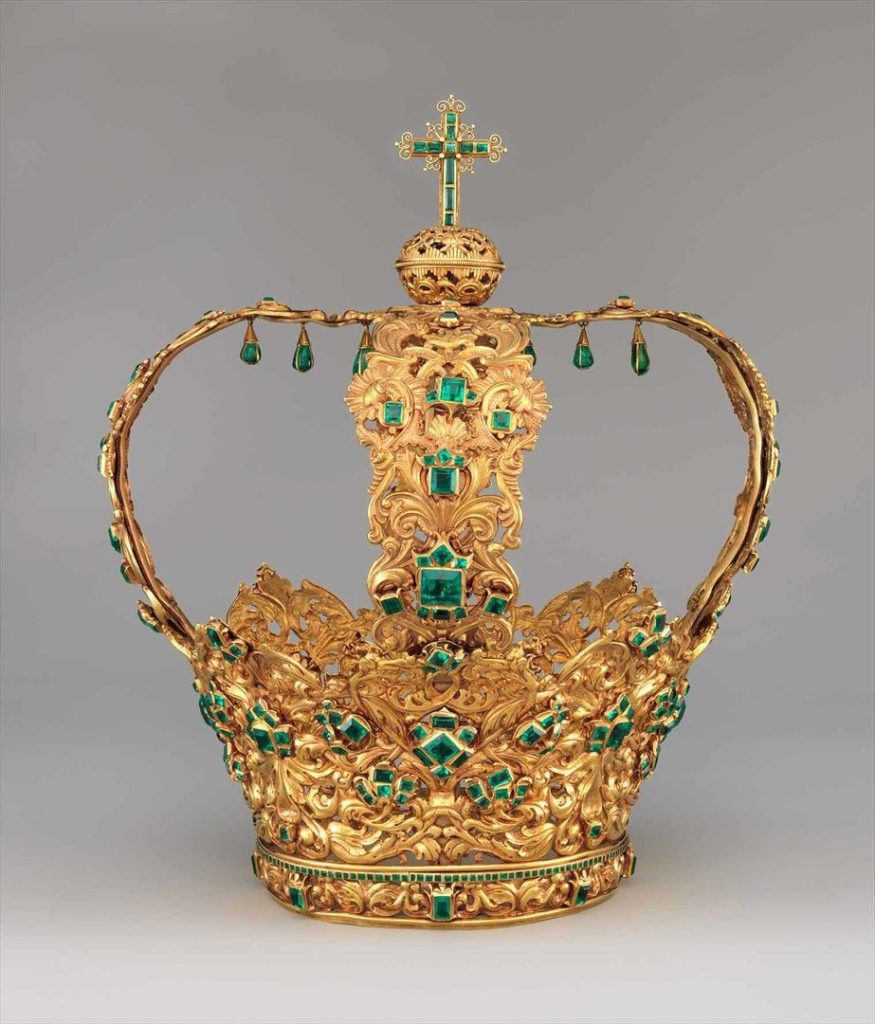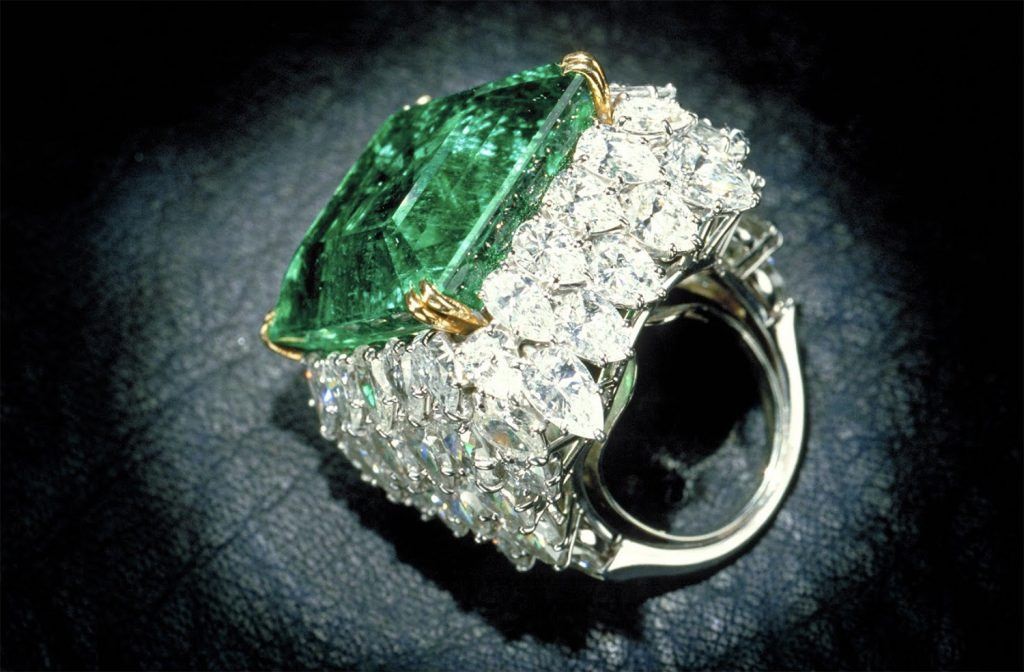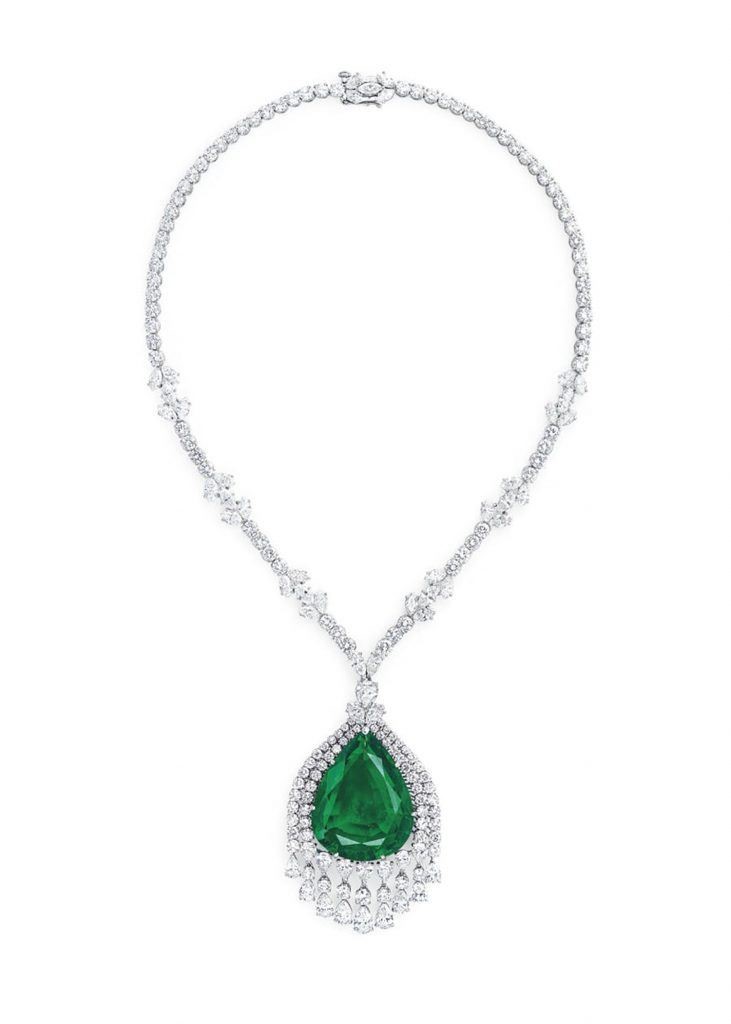The world’s most luxurious jewels famed for their Colombian emeralds
Colombian emeralds are notorious for being the most prestigious in the world. Throughout history, these vivid green gems have been chosen to adorn the finest jewels for both royalty and the rich and famous. Here are three luxurious jewels that are famed for their Colombian emeralds.

The Crown of the Andes
Currently residing in New York’s Metropolitan Museum of the Arts is the most prestigious surviving examples of Goldsmith’s work from Colonial Spanish America. The Crown of the Virgin of the Immaculate Conception of Popayán, was made to adorn a sculpture of the Virgin Mary, which would be paraded down the streets of Popayán during religious festivals. Exacting dates of origin are not known but experts have estimated that the diadem was made first in 1660 and the arches added later in 1770. In 1914, Pope Pius X allowed the crown to be sold which led to American gem dealer, Warren J. Piper, purchasing the crown in 1936. Piper lavished in owning such a spectacle and paraded it across America; exhibiting it at the 1939 New York World Fair, several Macy’s and even as a dinner table centerpiece. Piper coined the name ‘Crown of the Andes’ and exaggerated many legends associated with it to increase fascination. Consequently, experts are now unable to fully determine fact from fiction. However, one widely accepted theory is that the crown was made as a thank you to the Virgin Mary, from the townspeople of Popayán, for sparing them from the Smallpox epidemic that devastated much of the Americas in the late 1500s.
Whilst over five pounds of 20-karat gold has been expertly carved into lavish baroque scrolls, it is the 443 emeralds that make the ‘Crown of the Andes’ truly special. Most of the emeralds date back to the Colonial period and each have “unsurpassed” colour and clarity. At the centre sits the largest stone, the “Atahualpa emerald”, weighing 24-carats and believed to have belonged to the last Incan Emperor before being stolen by the Spanish conquistadors. Individually, the emeralds would be worth a fortune; so, with a combined weight of 1,500-carats, the crown is incredibly valuable both economically and historically.

The Chalk Emerald
Perched on a stand in the Gem Gallery at Washington D.C.’s National Museum of Natural History, sits one of the world’s finest Colombian emeralds. Illuminated by spotlights, the 37.8-carat gem glows a vivid green hue and has a clarity so fine it looks like glass. Alongside remarkable qualities, the stone has an air of mystery as its exact origins are unknown. Due to the rich colour, experts believe it could have originated from the Muzo mines which are famed for producing emeralds of a distinct green. These fine quality emeralds were much desired by the Mogul rulers of India, who had built a thriving gem and jewellery trade based on their appreciation of the jewels. The Chalk Emerald eventually found its way there and supposedly formed the centerpiece of an emerald and diamond necklace. The necklace was owned by Maharani Sita Devi of Baroba (now known as Vadodara). Devi was a flamboyant character with an infinity for all things luxury. Her controversial second marriage led to some referring to her as India’s own Wallis Simpson. After a life of extravagance, the Maharani fell on hard times and was forced to sell some of her jewels, which is when experts believe the emerald was bought by Harry Winston. For the jeweller celebrated for his emerald-cut jewels, there was no question as to what he would do with the gem. Originally weighing 38.4 carats, the stone was of course re-cut into Winston’s iconic shape, as well as surrounded by 60 pear-cut diamonds before being set into a platinum and gold ring. Despite the loss of a few carats, the emerald’s new shape and setting made it an impeccably luxurious piece of jewellery; one that caught the eye of Mr. O. Roy Chalk. For the successful American entrepreneur, the ring was a perfect gift for his wife who no doubt gratefully received it. The ring was owned by them until 1972, when they dominated it to the Smithsonian museum and, as a thank you, the ring received its namesake.

Catherine the Great’s Emerald Necklace
Nestled amongst circular, pear and marquise-cut diamonds and set within a platinum and gold necklace, this 75.61-carat emerald is the epitome of grandeur and has a provenance to match. The impressive stone is one of the few imperial jewels belonging to the Romanov dynasty that survived the Russian Revolution. The first known owner of the stone dates back to Russia’s most powerful and longest serving Empress, Catherine the Great. Originally the stone was a rectangle-cut, weighed 107.67-carats and was part of the monarch’s extravagant jewellery collection. After her passing, the stone was continuously passed down the family up until the death of Grand Duchess Vladimir in 1920, saw it bestowed to her son who later sold it. In 1927, the gem was bought by Cartier which marked the beginning of the stone as we know of it today. Cartier first mounted the gem into a diamond pendant before attaching it to a diamond necklace acquired by the jeweller’s gemstone supplier, Raphael Esmerian. The emerald didn’t bear its iconic pear shape until 1954, when Esmerian advised that, in order to maximise brilliance, the stone should be re-cut. Such advice proved valuable as later that same year, the finished necklace caught the eye of John D. Rockefeller Jr. It remained with the Rockefeller family up until 1971, when Esmerian bought it for himself at auction. The necklace has since been owned by a series of private collectors and, most recently, sold at a Christie’s jewels auction for an eye-watering £3.3million.
London DE offer a wide range of Colombian emeralds and can handcraft any bespoke piece to order. Get in touch with them today to arrange a free consultation and to find your perfect bespoke piece.
Visit their blog to explore similar articles.
By Holly Johnson


